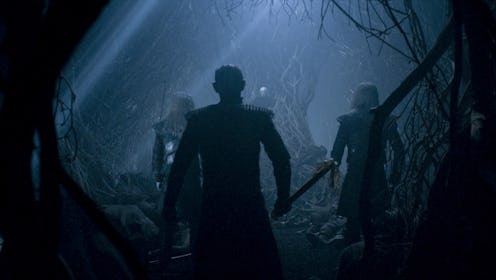Books
The Inspiration Behind The White Walkers From 'GoT' Explains Why They're So Terrifying

Dragons are impressive, sure, but pretty standard fantasy fare. The Children of the Forest are just re-branded hobbits with a dash of old school elf-lore thrown in. But what of the White Walkers? They rep hard for the "ice" side of George R.R. Martin's Song of Ice and Fire, but where did they come from? Those tall, blue-eyed figures with their inscrutable agenda and their many undead friends are already iconic fantasy villains, and Martin certainly deserves the credit for creating an original race of icemen with attitude.
All high fantasy novels pull from history and mythology, though, and ASOIAF is no exception. Maester Martin has been perfectly upfront about the fact that the main plot of A Game of Thrones is based on the English War of the Roses. The Targaryens remix elements of Ancient Rome, Ancient Egypt, and the Norman Conquest (but with dragons), and, like every euro-centric fantasy realm, the Seven Kingdoms owe a huge debt to Tolkien's Middle-Earth.
When it comes to the White Walkers (or the Cold Gods, or the Others, or the Night King and His Buds), however, Martin went back further than Tolkien and the Plantagenets, long before the Normans left Normandy, mixing together ancient folklore and a modern day crisis to create the most mysterious creatures in Westeros.
To begin with, Martin has confirmed that the threat of the "Long Night" in ASOIAF is an allegory for climate change in our own world. While the noble families of Westeros whine and wring their hands over who will rule what and which kid falls next in the succession for the Big Pointy Chair, a winter is fast approaching that could last for generations. It could wipe out civilization entirely. It's unclear whether the White Walkers are causing this mega-winter, or simply a symptom of the inevitable climate crisis, but either way it's bad news for humanity.
There actually was a "Little Ice Age" around the beginning of the 14th century, when temperatures suddenly plummeted and Northern Europe was subjected to unusually short summers and long, brutal winters. Martin seems to have taken this historical anomaly and cranked it up to 11, adding in our modern day anxieties about catastrophic global warming and, of course, snow zombies. Martin has also hinted that the out-of-whack seasons on Eartheros are the result of some kind of magical intervention, not a natural phenomenon (perhaps too many dragons pumping carbon dioxide into the air?).
The White Walkers aren't just harbingers for the real-world horror of climate change, however. They're also fairies. Or, at least, Martin based them in part on the sidhe, a race of mysterious Fair Folk in Irish and Scottish mythology. The HBO show gives them a sort of a corpse-chic look, but in the books they're described as beautiful, inhuman, elegant — and certainly not dead. The sidhe themselves could be achingly beautiful or horribly grotesque. They were often tall and regal, unlike the diminutive leprechauns. They lived apart from humans, in hidden kingdoms under mounds (often burial mounds), or in an unseen Otherworld. They were somewhere between gods and people and nature spirits, nearly always protective of their homeland. And they weren't necessarily evil... but they were dangerous. Especially if you neglected to leave them offerings.
So could the White Walkers simply be miffed that humans have encroached on their land and stopped leaving them presents? Possibly. Fans know that at least one human does still leave them offerings: the wildling Craster gives all his sons to the "Cold Gods." The books don't reveal what happens to the babies, but the TV show implies that the sons of Craster become White Walkers themselves. This is similar to changeling stories in European folklore, where babies would be snatched away by fairies and replaced with a strange, otherworldly fairy child.
Westeros is clearly a riff on the historical British Isles, but there are also some serious Scandinavian and Germanic vibes going on, especially up North. Beyond the sidhe, White Walkers are also rather similar to the frost giants, or jötunn, of Norse Mythology. These "giants" didn't have to be huge, but they were a race apart from gods, men, elves, and dwarves, most of them with wintry domains and icy powers. They weren't always evil, but they were usually difficult to get along with (Loki, everyone's trickster god crush, was a jötunn), and they often fought with the main pantheon of Norse gods. The gods even tried to build a big magic wall to keep them out.
Coincidentally, the head honcho god in Norse mythology, Odin, is a one-eyed, all-seeing old man who keeps ravens and wolves and sometimes hangs out in a magic tree. You know... like that one-eyed, all-seeing old man in the tree with the ravens who the White Walkers hate so much?
Mythology is also full of creep-tastic undead armies. Martin's wights are definitely influenced by our modern flavor of shuffling, brain-dead zombies, who hail from West African folklore that's been remixed by Hollywood. But his undead creatures must be raised by the White Walkers themselves, much like the mythic Valkyries would resurrect dead warriors so they could continue to fight in the afterlife.
The White Walkers and the wights are also very similar to the Nordic draugr, an undead corpse who would guard its own grave. Like the wights, draugar are immune to weapons besides iron, and must be dismembered and burned to be properly disposed of. Like the White Walkers, they can control the weather and slip into people's dreams.
It's no wonder the White Walkers are so perfectly terrifying: they combine real life environmental horror with half-remembered folklore. They play off cultural fears of the cold and the dead.
And hopefully they can be defeated, or at least understood, before the Long Night truly begins.